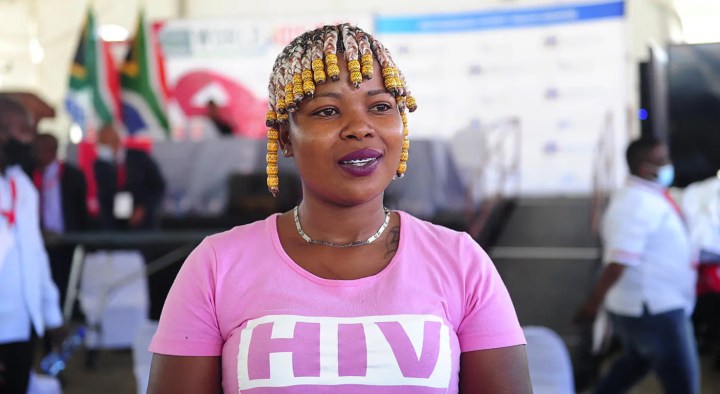SPOTLIGHT
Integrating HIV and NCD care is critical but not straightforward, clinicians say

With the remarkable success of antiretroviral treatment people living with HIV in South Africa are generally living much longer than they did two decades ago. As a result, more people with HIV are also now living with non-communicable diseases such as diabetes and hypertension. Accordingly, the need to better integrate HIV and NCD services was a hot topic at the recent Southern African HIV Clinicians Society conference in Cape Town.
Thanks to antiretroviral treatment, overall life expectancy in South Africa has shot up by about nine years since the peak of the country’s HIV epidemic in the early 2000s. As a result, more people with HIV are also now living with noncommunicable diseases (NCDs) such as diabetes and hypertension.
The dynamic of an ageing population living with HIV is not unique to South Africa, as recently outlined in this article in the journal Lancet Global Health, but the size of our HIV epidemic means the scale of the effect here is substantial. According to estimates from Thembisa, the leading mathematical model of HIV in South Africa, there are about 1.7 million people 50 years and older who are living with HIV in the country. This number is projected to rise rapidly in the coming years as people living with HIV who are now in their forties get older.
“Improved life expectancy among adults living with HIV, coupled with increased time on antiretroviral therapy, has led to an increase in noncommunicable disease prevalence, with cardiovascular disease, depression, cancer and diabetes increasingly common,” write the article authors.
In addition to ageing, having HIV in and of itself is a risk factor for developing several comorbidities, although these risks are massively reduced by antiretroviral treatment. People living with HIV, for example, have an increased risk of both mental health conditions and heart disease.
It was thus not surprising that the need for a different approach to HIV – one that does a better job of integrating treatment and care for comorbidities – was a hot topic at the sixth Southern African HIV Clinicians Society (SAHCS) conference, held in Cape Town recently.

In addition to ageing, having HIV in and of itself is a risk factor for developing several comorbidities, although these risks are massively reduced by antiretroviral treatment. (Photo: Fotolia / TNS / Spotlight)
‘The new threat’
Dr Arifa Parker, an infectious disease specialist who spoke at the conference, said people living with HIV are now living longer, which is a positive “but we are now facing the new threat of noncommunicable disease in this patient population”.
“We saw mostly patients with advanced HIV [in the past]… but now in our emergency units we are seeing patients with HIV well controlled, on ARVs with viral loads suppressed, but the noncommunicable diseases are neglected, blood pressure is sky high, and the patients are presenting with brain bleeds, kidney disease and so forth,” she said.
There is a growing evidence base to back up such observations. A study published in 2019 in the BMJ global health journal that looked at older adults in South Africa, found that “people living with HIV have high prevalence of multimorbidity”.
“Recent data shows that with ageing, the number of people living with HIV with NCDs and other comorbidities is increasing and adding to the disease burden,” Dr Josephine Otchere-Darko, programme head for Ekurhuleni in Wits RHI’s HIV/TB programme, told Spotlight. Quoting the BMJ study, she added: “The prevalence of chronic conditions in people living with HIV is reported to be greater than 50% in [over-] 50-year-olds, with hypertension, diabetes and depression accounting for the bulk of disease.”
Not a new idea
One of the ways to achieve better management of HIV and comorbidities like diabetes and hypertension, according to Otchere-Darko, is through the integration of healthcare services. The BMJ study concluded the same thing: “Our findings highlight the importance of providing integrated care, such as campaigns that combine communicable and noncommunicable disease screenings into a community-level HIV testing drive…”
Defining integration is tricky – one World Health Organization (WHO) document lists six definitions. The essence seems to be the idea that people should ideally receive all the treatment and care they need from as few healthcare workers and as few health facilities as possible. Rather than a simple either/or, most health services will fall on a continuum between strict silos and full integration. In 2010, activists called on the South African government to accelerate the integration of HIV and tuberculosis services – integration with NCDs takes that a step further.
That the need for better HIV/NCD integration is real has been recognised for some time. For example, in 2008 the WHO produced a technical brief on how to go about integrating HIV and NCD services. The WHO has since published another technical brief on the matter.
“National responses for both HIV and NCDs require health systems that can deliver effective acute and chronic care and support adherence to treatment. Chronic HIV care also provides an opportunity to assess, monitor and manage NCDs, especially in primary care,” reads the brief.
“Integrating interventions for the prevention and management of major NCDs in people living with HIV care can reduce the risks of NCDs among people living with HIV and improve HIV treatment outcomes. Furthermore, integration of NCDs services into HIV service delivery models and provision of integrated care will contribute to sustaining the gains made in survival by the introduction of antiretroviral therapy.”
Optimising integration, according to Otchere-Darko, can reduce how often people living with HIV have to visit health facilities as well as improve treatment continuity. This could make accessing healthcare services more convenient and increase the chances that health problems will be picked up early, such as by screening for diabetes during a visit that otherwise might just have focused on HIV. If well implemented, integration could thus also reduce the load on healthcare facilities and contribute to greater efficiency.

The need for better integration of HIV and NCD care has been recognised for some time, but practically implementing it is a complex task. (Photo: Samantha Reinders / MSF / Spotlight)
What integration actually looks like
While the idea of integration was widely supported at the SAHCS conference, questions over what integration actually looks like in the day-to-day reality of our healthcare system, led to several rich discussions.
Dr Denasha Reddy, an internal medicine and infectious disease specialist at the University of the Witwatersrand (Wits), who chaired a panel discussion on the issue, said that integrated care is really about “how we link up health services for individuals in a way that can meet their needs in an efficient way”. She said this is a complex task because it is looking at more than just clinical services, it’s also about organisational integration. “I think it’s necessary, but it requires a lot of thought, a lot of collaboration. It needs political will. There needs to be some sort of coordination at a higher level.”
Integrating HIV and NCD care for people with HIV, while paramount, is complex and because of that it won’t be “a quick fix”, said Samanta Lalla-Edward, director of research development at Ezintsha at Wits, who also spoke at the conference.
“When we’re thinking about how we’re going to actually address [integration of] NCDs into the HIV, or any kind of integration, we know that we’re going to need a multicomponent intervention and to have this multicomponent intervention, it’s going to be complex and because it’s going to be complex we’re not always going to catch disease,” she said, adding that this kind of integration should be aimed at the primary healthcare level and address multiple health issues at the same time.
Consensus on screening
One area in which there was much agreement at the conference is that we need to improve screening and management of blood pressure, diabetes and obesity. According to Parker, these are things that clinicians who already work with people living with HIV can already incorporate into the management of their patients.
“I think we as HIV providers need to upskill ourselves as a matter of urgency on how to manage these NCDs. Like blood pressure [checks] must be done at every visit, weights and heights must be measured. We must encourage stopping of habits that would result in chronic diseases. So, there’s no argument about it, we have to incorporate them into our management of patients. We’re going to be doing a disservice to our patients and we’re seeing that in clinical practice,” Parker said. “I think this is the next step of ARV care.”
Read more in Daily Maverick: Doctors Without Borders closes ground-breaking HIV/TB Eshowe project, but warns ‘HIV isn’t over’
But, as pointed out by several speakers, to implement such changes and to get the maximum benefit out of them will require several changes to how things are done. It may, for example, require changes to clinical stationary and more integrated electronic medical record systems that allow for a person’s HIV and TB information to be tracked together with their NCD or mental health-related information. Additional training and support for healthcare workers may also be needed.
“All healthcare workers should be skilled and supported to provide holistic management of people living with HIV at all visits with clear and adequate documentation,” said Otchere-Darko. “Additionally, existing data gaps within the health system, such as lack of age disaggregation for adults living with HIV for reporting and management purposes, absence of routine measurement and tracking platform or system for comorbidities and their outcomes, should be addressed.”

Discussions among clinicians at the sixth Southern African HIV Clinicians Society conference concluded that there is a need to improve screening and management of blood pressure, diabetes and obesity in people living with HIV. (Photo:Rosetta Msimango / Spotlight)
From a policy and treatment guidelines perspective, South Africa has taken several steps toward integration. In 2012, the Department of Health introduced the Integrated Chronic Disease Management (ICDM) model – essentially a strategy for dealing better with different diseases at primary healthcare level (see an implementation manual here). But Lalla-Edward said the ICDM model hasn’t been successful and “we are nowhere near being able to deliver that model effectively”. “For it to be successful, it requires continuous refinement and adaptation and to evolve to what the need is and what we have at that time.”
Elements of integration are also found in several guideline documents – the 2023 Revised Antiretroviral Therapy (ART) guidelines, for example, outline a visit schedule for integrated care for a mother and baby living with HIV and for clients on ART and drug-sensitive TB treatment.
Barriers to integration
But, as pointed out by Lalla-Edward, integration faces several barriers, “particularly in resource-limited settings where the healthcare infrastructure is constrained”. In such contexts she stresses the importance of commitment, both from the healthcare system and from “organisations to provide the necessary infrastructure, resources and training to support integrated care”. “And more importantly”, she said, “we also need the ongoing evaluations and adaptations to be able to meet the unique needs of the population and the setting that we are serving”.
Some challenges, according to Otchere-Darko, include a lack of adequately skilled healthcare workers at primary healthcare level versus the tertiary level, and the absence of “an electronic or adequate documentation and monitoring system for continuum of care and difficulty in managing drug-to drug interactions and contraindications without effective pharmacovigilance”.
“The reality is that even with all the knowledge and the information that we have, integration models suffer severe constraints and that could be because of anything from technical capacity, infrastructure to supply chain,” Lalla-Edward said. DM
This article was produced by Spotlight – in-depth, public interest health journalism.


















 Become an Insider
Become an Insider
Comments - Please login in order to comment.